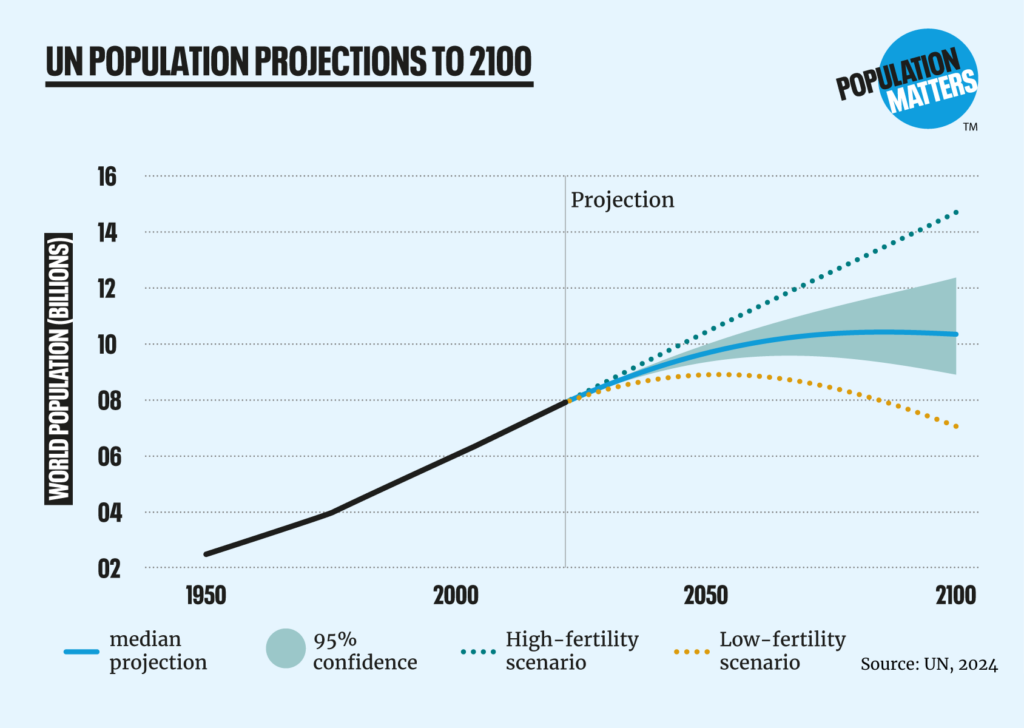
After the Spike and the Myth of Depopulation
After the Spike by Dean Spears and Michael Geruso focuses on depopulation, but its arguments are built on shaky ground, stirring up fear, rather than focusing on the facts. What’s more troubling is the authors don’t disclose their funding from Elon Musk, who has frequently made headlines with his concern over low birth rates. Here we’ll break down the flaws in their arguments.
In After the Spike, Dean Spears and Michael Geruso, economic demographers from the University of Texas at Austin, predict that unless the trend for low birth rates is reversed, the world’s population will peak in the next four to six decades and then fall exponentially.
However, these arguments do not align with the most widely cited projections of global population put out by the United Nations.
The substance of Spears and Geruso’s arguments fall more into pronatalist ideology than rationality, perhaps explained by their sources of funding. A Bloomberg investigation revealed that in 2021, Elon Musk donated $10 million to the University of Texas at Austin for the development of the Population Wellbeing Initiative (PWI), which is headed by Dean Spears. Elon Musk has repeatedly spread misinformation about population collapse, claiming it is a “bigger crisis than climate change” – which is false given the global population is set to keep growing and is expected to reach 10 billion before the end of the century.
Here we will unpack the main arguments of After the Spike and sort out the fact from fiction.
After the Spike Myth 1 – Depopulation is a crisis
After the population peaks in about 60 years, it’s not expected to then plateau or stabilize. If birth rates stay the same, it will continue to drop without end, bringing the global population back down to a size not seen for centuries, possibly eventually all the way down to zero.
After the Spike argues that due to a trend of low birth rates – narrowly focused on the Global North – that the global population will peak then plummet off a cliff. This misinterprets the most widely cited demographic projections put out by the United Nations in 2024, that the world population is expected to peak at 10.3 billion people in the mid-2080s, it will then plateau and remain relatively stable hovering above 10 billion through to the end of the century.
Instead, After the Spike stirs a false panic that we must all start having more children to increase the current birth rate and concerningly fans the flames of “depopulation” conspiracy theories.
The reality is the current trend of low birth rates primarily in the Global North – as the Global South still has predominantly high birth rates though they are trending downwards – is due to a range of factors.
Low birth rates are in part a development success story, reflecting more women pursuing higher education and careers, with access to contraception meaning more women have the freedom to choose whether or when they have a child.

However, as the latest UNFPA 2025 report revealed, many people report being unable to start a family or have as many children as they want primarily due to financial barriers. After the Spike gets it right in proposing governments adopt policies that make parenthood easier and more accessible. However, these policies should be embraced regardless, independent of an agenda to increase birth rates as no one should feel pressured to have children from a state power nor feel they have been priced out of parenthood due to financial constraints.
We should create a society where everyone is able to freely exercise their reproductive rights and realise their choices about their desired family size. This includes individuals right to make decisions concerning reproduction free of discrimination, coercion and violence.
After the Spike aims to scare us into the idea that any decline in the size of the global population would be catastrophic. When the real fertility crisis that needs to be urgently addressed is the fact that millions of individuals, especially women and young girls, are unable to exercise their reproductive rights due to persisting socio-economic barriers, gender-based violence, as well as legal restrictions with the rise in anti-choice laws. It’s a global injustice that millions of women and young girls around the world are unable to make free choices about their fertility and their own bodies.
To address this crisis, Population Matters works with our grassroots partners to remove barriers to people exercising their reproductive rights through Empower to Plan.
After the Spike Myth 2 – Innovation is driven by numbers of people
One reason is that other people make the discoveries and have the ideas that improve our lives. Other people are where science and knowledge comes from.
After the Spike argues that scientific innovation is tied to the size of the human population. Scientific discovery originates from investment in education and research, not the number of people on Earth.
According to UNESCO, 251 million children and youth remain out of school. With stark disparities between regions, 33% of school-aged children and youth in low-income countries are out of school compared to only 3% in high-income countries.
Ensuring that everyone has equal access to education, and opportunities to pursue careers in science and engineering, is what will deliver more scientific innovation and discovery.
After the Spike Myth 3 – Population is not related to environmental problems
People do destructive activity, but the way we stop that is by stopping the destructive activity with better policy and better enforcement and implementing better technologies. We’ve never solved a problem like that before with less people.
After the Spike cites the example of China’s “airpocalypse” when the capital Beijing dealt with infamously bad air pollution categorised by the heavy smog that cloaked most of the city. After 2013, the Chinese government brought in stricter industry regulation that effectively halved the level of air pollution, even whilst China’s population grew by 50 million people. This is cited as proof that environmental problems can be solved even whilst the population continues to grow. Air pollution is only one of many complex environmental crises that the world faces. One of the most serious challenges the world faces is climate change, where there is clear evidence that population growth is a significant driver.
Globally, Gross Domestic Product (GDP) per capita and population growth remained the strongest drivers of CO2 emissions from fossil fuel combustion in the last decade.
To solve the environmental crises the world is facing, we must acknowledge and address the impacts of our growing global population, alongside reducing our consumption – especially in richer countries. Effective policy regulation can make significant strides to reduce consumption and clean up pollution. In addition, consistent investment in improving access to education and sexual and reproductive healthcare for everyone is one of the positive solutions to achieve a higher quality of life for all people. We advocate for solutions that build interrelationships between population, resources, the environment and development to achieve harmonious balance.
Final Thoughts
After the Spike frames the current trend of low birth rates predominantly in the Global North, as our collective moment of doom, with Dean Spears in interviews rather earnestly calling for humanity to avoid its own extinction.
But the demographic reality is, humanity isn’t going anywhere.
To make progress governments and the private sector must increase funding for the delivery of sexual and reproductive health and rights (SRHR). Evidence supports that investing in SRHR is one of the most cost-effective development interventions they can make returning up to US$120 for every US$1 spent.
Population Matters previously published a report debunking Musk’s claims and highlighting the amount of misinformation he has spread about population on his platform X. You can read the Elon Musk report here.



